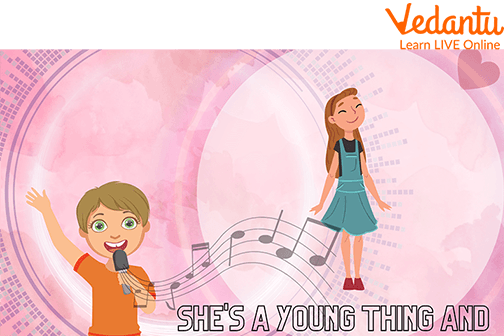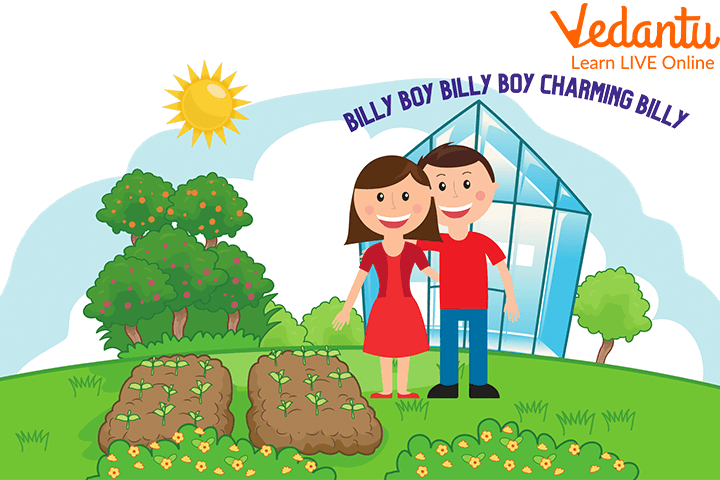An Introduction to the Poem Billy Boy
Do you like singing traditional folktales that are like rhymes but only with a very exceptional storyline? Billy boy nursery rhyme is one such catchy folklore which was popular and once memorised is difficult to forget. A little boy who is on a mission to find himself a wife who can make a cherry pie, a feather bed, and is tall, tells us about the girl through this rhyming folklore. So let’s read the Billy boy song lyrics, which are about his quest to find himself the girl that he is describing to us.

Billy Boy and His Dream Girl
Theme of the Poem
The tone of the nursery rhyme, which is written in question-and-answer format, is humorous and sarcastic. The nursery rhyme and folk tune "Billy Boy," which has its roots in 19th-century England, is well-known in America. The song, which was formerly known as Willie Lad and Charming William, is most likely a version of Lord Randall.
Billy Boy Billy Boy
Oh billy, billy, billy, billy
Where had you been,
Billy Boy, Billy Boy?
Hey, where Had you been,
Charming Billy?
I have been to find a wife,
She’s the cheer of my life,
She’s a young girl
And cannot leave her mother.
Oh billy, billy, billy, billy
Did she ask you to come in,
Billy Boy, Billy Boy?
Did she ask you to come in,
Charming Billy?
Yes, she did ask me to come in,
There’s also a dimple in her chin.
She’s a young girl
And cannot leave her mother.
Hey, Can she make a cherry pie,
Billy Boy, Billy Boy?
Can she make a cherry pie,
Charming Billy?
She can really make a cherry pie,
as Quick as a cat winks an eye,
She’s a young girl
And cannot leave her mother.
How old is she,
Oh, Billy Boy, Billy Boy?
How old is she,
Oh, Charming Billy?
She’s Three times six, four times seven,
She’s Twenty-eight and eleven,
She’s a young girl
And cannot leave her mother.
Hey, Can she make a feather bed,
Billy Boy, Billy Boy?
Can she make a feather bed,
Oh, Charming Billy?
Yes, she can make a feather bed,
while standing on her head,
She’s a young girl
and cannot leave her mother.
Hye, How tall is she,
Billy Boy, Billy Boy?
How tall is she,
Oh, Charming Billy?
She is as tall as any pine,
and as straight as pumpkin vine,
She’s a young girl

Billy Boy Singing
Hey, How old is she,
Billy Boy, Billy Boy?
How old is she,
Oh, charming Billy?
She is sixty times eleven,
She’s twenty-eight and forty-seven,
She’s a young girl
and cannot leave her mother!
Are her eyes so bright,
Billy Boy, Billy Boy?
Are her eyes so bright,
Oh, Charming Billy?
Yes, her eyes are so bright,
but alas, they’re minus sight
But she’s a young girl
and cannot leave her mother!
Can she also sing a pretty song,
Billy Boy, Billy Boy?
Can she sing a very pretty song,
Oh, Charming Billy?
She can sing a pretty song,
but she often sings it wrong
But she’s a young girl
and cannot leave her mother!
Is she fit enough to be a wife,
Billy Boy, Billy Boy?
Is she fit enough to be a wife,
Oh, Charming Billy?
She’s as fit to be a wife
as a fork fits to a knife
But she’s a young girl
and cannot leave her mother!

Charming Billy
Summary
From the billy boy song lyrics, we have seen that this nursery rhyme circles around a young boy named Billy who is overly optimistic about his thoughts of a girl who he thinks he would marry. In the American folk song and nursery rhyme "Billy Boy," the title character, is asked about various topics, and his responses are always focused on his strong desire to think of a girl who is supposedly too young to leave her mother. He also mentions that she is too young to get married, and also she can't leave her mother. We hope that you enjoyed this amazing rhyme.


FAQs on Billy Boy - Nursery Rhymes
1. Who introduced folklore and when was it published?
It is a version of the old English folk song "My Boy Billy," which Ralph Vaughan Williams recorded and released in 1912.
2. What does Folklore Mean?
Folk, which refers to local people, and lore, which refers to stories, are the two nouns that make up folklore. Folklore hence reflects tales shared by locals in a certain area. Through its literary themes, folklore can describe a population's ideals, views, and desired way of life.
3. What is a folktale's central theme?
Generally speaking, folklore refers to cultural expressions such as stories, jokes, beliefs, proverbs, legends, and myths as well as music, songs, dances, costumes, food, and festivals that help individuals and groups create and spread a sense of shared identity.





